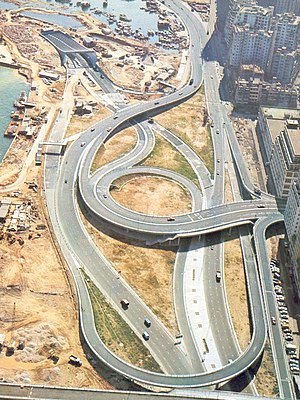1970s in Hong Kong
Hong Kong in the 1970s underwent many changes that shaped its future, led for most of the decade by its longest-serving and reform-minded Governor, Murray MacLehose.
The British and the PRC governments began a long negotiation process that would ultimately lead to the Handover of Hong Kong in 1997.
Under Sir Murray MacLehose, 25th Governor of Hong Kong (1971–82), a series of reforms improved public services, the environment, housing, welfare, education and infrastructure.
A number of MacLehose's most significant policies included: With the rising public service provision came a clampdown on the free flow of refugees from mainland China that had powered the growth of Hong Kong since the Second World War.
Seventy-two percent of overseas graduates between 1962 and 1976 would come back to Hong Kong to take on highly skilled domestic positions.
[6] The theme songs of these dramas also helped revive Cantonese music - indeed the term Cantopop was coined during this period.
The martial arts films starred by Bruce Lee, including the 1971 The Big Boss (唐山大兄) and Fist of Fury (精武門) the following year, were sensational.
The film featured the wreck of SS Seawise University and that of the famous former Cunard Ocean liner RMS Queen Elizabeth.
In August 1971, Typhoon Rose passed over Hong Kong causing extensive damage, forcing the hoisting of Hurricane Signal No.
Policemen would often extract bribes (popularly called "tea fee") before they investigated a crime, as did firemen before they rescued people and put out fires.
In 1974, Hong Kong Governor Murray MacLehose, realising the seriousness of the problem, founded the Independent Commission Against Corruption (ICAC).
The Governor, concerned to avoid a possible police strike or even rebellion, at last issued a pardon, preventing arrests in cases committed before 1977.
These high-level Chinese officers, famous for their riches, left for exile to Taiwan, which had no extradition treaty with Hong Kong.
In time, the efforts of the ICAC changed the habits of an entire population and turned Hong Kong into one of the least corrupt cities in the world.
[citation needed] The "Hong Kong Federation of Students" (香港專上學生聯會) requested a protest at Victoria Park in Causeway Bay on 7 July 1971.
Along with the opening up of global trade with China via the 1978 economic reforms, factories were gradually relocated to the mainland, where labour costs were lower.
The government also introduced the Home Ownership Scheme (居者有其屋計劃) in 1976, building houses and selling them at below-market prices to help people own property.
It was called "Gweilo market" by some locals, as most customers were westerners during the initial period of its operation, but Chinese citizens would soon embrace this new kind of store.
The front and full-page ads of these two mega franchises aided in their increase in popularity where smaller traditional stores couldn't.
Kai Tak Airport was expanded in the first half of the 1970s to handle Boeing 747s, despite the limited land space and proximity to nearby hills.
A minimum capital of HK$5 million and liquidity ratio of 25% and limitation on loans and investments became the new requirements to operate legally.
As a result of the water shut-down by mainland China during the Cultural Revolution riots in Hong Kong, the government responded with a desalination plant at Lok On Pai, Castle Peak in 1975.

